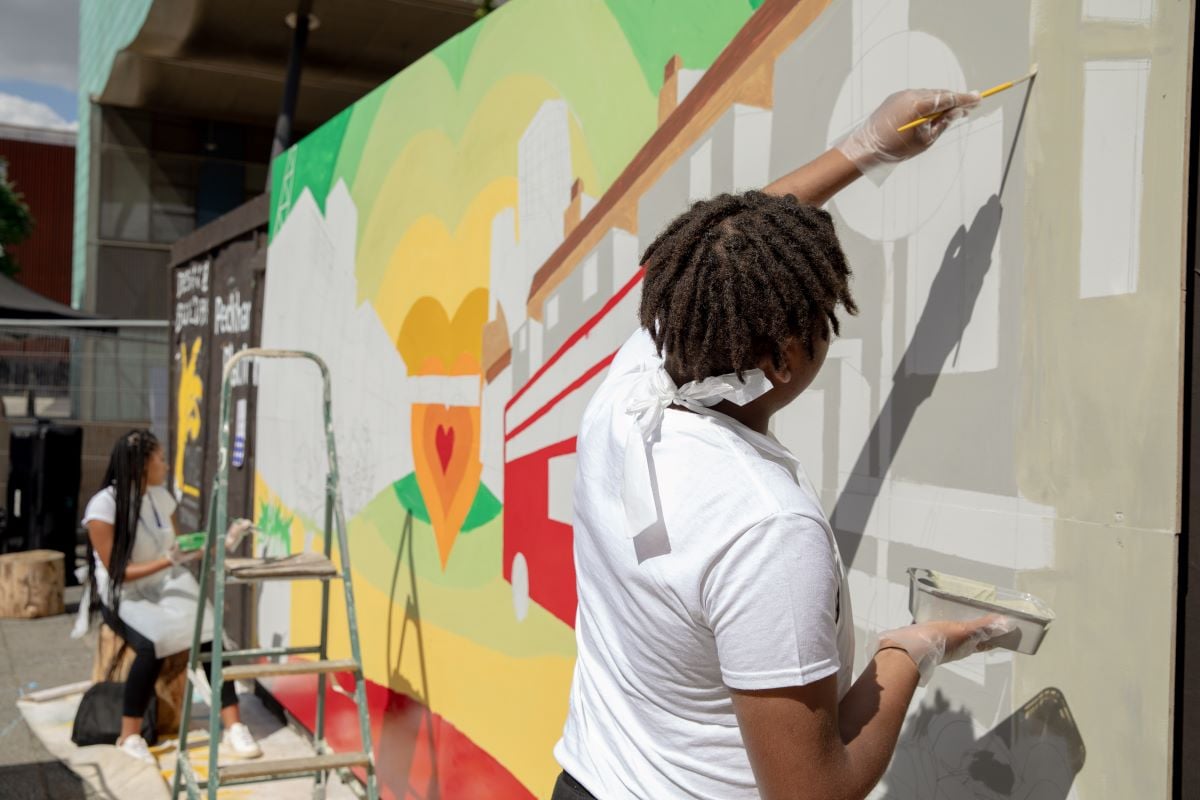
Community mural being painted in Peckham Square: an example of the kind of work that can be funded through CIL
Photo: Peckham Platform
An underutilised source of community arts funding
Local authorities are central to the UK’s planning system. Lucy Atkinson explains how Community Infrastructure Levy funding can provide opportunities for arts organisations to work creatively with communities.
The whirr of construction is a familiar sound in towns and cities across the UK. Less familiar though is Community Infrastructure Levy (CIL) funding, legislation that enables local authorities to raise money from these developments for community use.
At a time of austerity when competition for funding is more stretched than ever, arts organisations and artists need to diversify their incomes and look beyond traditional funders. Fortunately, community-focused creative projects align well with the ambitions of local councils.
As a programme manager and fundraiser working with grassroots organisations, local authorities and artists, I know that sometimes the people best placed to deliver community projects are unaware of this funding. If you’ve never heard of CIL, you are not alone.
What is CIL?
To understand the opportunities this funding offer, we need an overview of how it came to be. Back in 1990, Section 106 funding was introduced which aimed to ensure that new, large-scale developments paid for the infrastructure supporting them – such as roads, cycle lanes and schools. This financial contribution from developers to local authorities was negotiated on a case-by-case basis.
The policy quickly came under fire. Only a small proportion of new developments (c.6 or 7%) actually resulted in a Section 106 agreement. Without any other levies, the focus on a small number of big projects left over 90% of developments off the hook for any contribution. And terms were negotiated individually, there was little certainty of how much would be raised.
So in 2008, central government introduced a new option for local authorities in England and Wales: Community Infrastructure Levy (CIL) charges. This differs from Section 106 as it applies to a far wider range of developments, not just major ones. CIL is determined by the size and type of floor space being built. The amount of money is also pre-set by a published tariff schedule eliminating the uncertainty that existed with Section 106. CIL does not apply in Scotland.
How do local authorities manage the levies?
Local authorities are encouraged, but not required, to apply CIL policies in their local areas. Most raise money for community use through this mechanism and distribute it in one way or another. Meanwhile, Section 106 policies have been reformed to restrict their use; they still apply to some developments but have largely been replaced by CIL.
Because CIL is designed to give agency to the local authority, there is variation in how it works from place to place. This includes the amount of the tariff as well as what it is spent on. To find out what your local authority’s policy is, check its website or ask your local councillor.
Some, like Portsmouth City Council’s CIL Transformation Fund, use the CIL to offer match funding. Others like Southwark Council invited members of the public to vote on the use of CIL. Brighton and Hove Council decides 75% of theirs, but the remaining 25% will be voted on by the public next year. Whatever the decision of your local council, there is clear potential for more funding for community art projects using CIL funding.
Where do artists fit in?
Artists and local arts organisations are uniquely placed to deliver on the aims of these funds. Facilitation skills, community connections, adaptable and inclusive approaches and the ability to communicate in non-traditional ways are skills we sometimes take for granted in the arts.
But these qualities are essential where developments impact local communities who often struggle to be seen and heard in the process of regeneration. They are also qualities councils look for when selecting projects to ensure the funds levied are channelled into projects with tangible benefits for local people.
There are many types of projects that could benefit. Some result in changes to the public realm, such as murals or the co-design of creative playgrounds. Others are more process-based, like mapping heritage or collecting oral histories.
Examples of effective collaboration on place-based projects include CatARTic in Watford. It has been allocated funds for a community artwork through the local CIL scheme. And in Kilburn, London, Linett Kamala, a multidisciplinary artist and DJ, and Wood Street Walls CIC have been commissioned to create a series of murals on the High Street funded by Camden and Brent councils and the Greater London Authority.
What next?
To better understand the available opportunities, there are some generic resources online.* But arts-specific training and resources that are easier to understand are needed, as is peer-to-peer knowledge sharing to help spread the word.
For councils, demystifying the planning process and reaching out to arts organisations and practitioners in the local area is a good place to start, alongside publishing contact details for relevant councillors and planning teams who can guide potential applicants.
Planning jargon is easy to skim over. But with so much potential to unlock funding for place-based creative projects with communities at their heart, CIL is definitely an acronym worth investigating.
Lucy Atkinson is a freelance Programme Manager.
![]() @lucyvatko
@lucyvatko
![]() Lucy Atkinson
Lucy Atkinson
*Resources
https://www.gov.uk/guidance/community-infrastructure-levy
https://www.museumoflondon.org.uk/application/files/5314/8612/5863/cil-and-S106-factsheet.pdf

Join the Discussion
You must be logged in to post a comment.